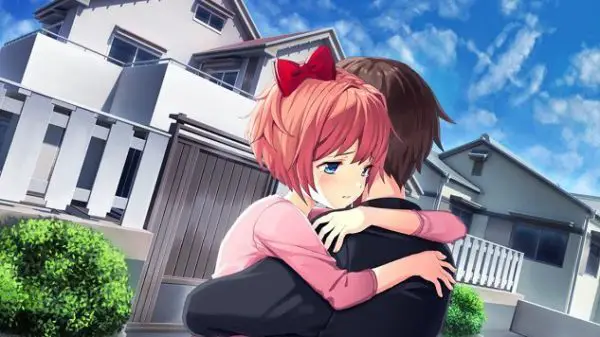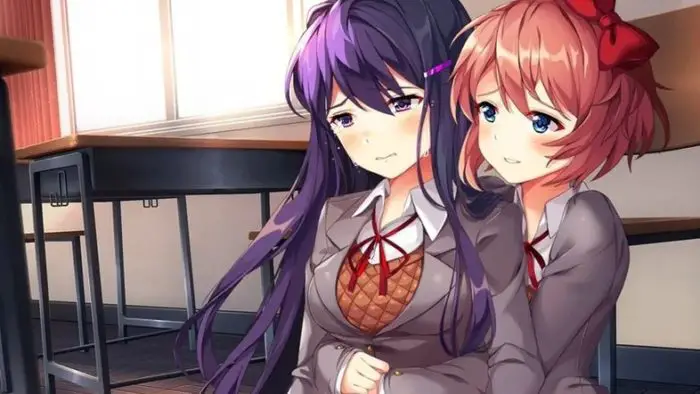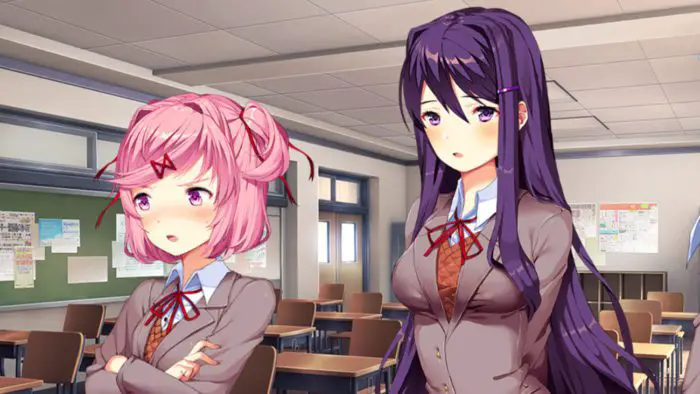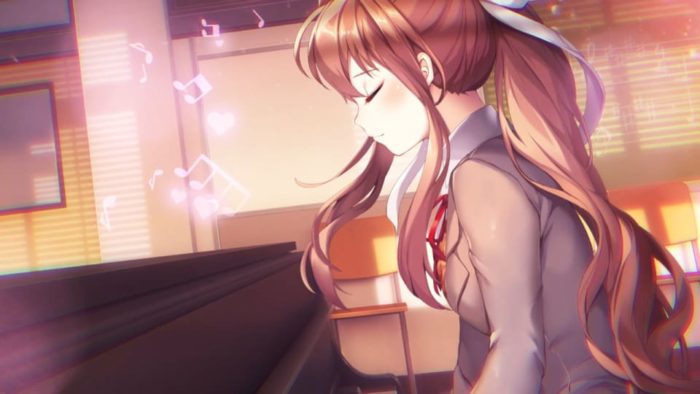When the original Doki Doki Literature Club (DDLC) is booted up, a message is displayed:
This game is not suitable for children or those who are easily disturbed.
Indeed, this game gets dark. As anyone who has played it knows, DDLC hides its true nature behind a veneer of cute high school girls and romance. What begins as an everyday dating sim quickly transforms into an exploration of heavy themes. The game gets even darker as it bends the visual novel genre in increasingly bizarre and clever ways. This cleverness earned DDLC high marks when it premiered in 2017 on Steam. The praise encouraged Dan Salvato and his team to create DDLC+!, an extension of the original game. Is it worth checking out for the new content alone, even at its price point of $15.00?
The Lit Club From Hell

The main scenario of the game remains largely the same. You play as a high schooler who is roped into joining an after-school club by his cheery childhood friend, Sayori. She introduces you to your clubmates. There’s Monika, who’s popular and athletic, Natsuki, who is fiery, short-statured, and pink-haired, and Yuri, who is bookish, slightly awkward, and obsessed with the color purple. Through spending time with the girls and writing them poetry, you get the chance to grow closer to one of them romantically. That’s act one of the game. Then the game shows its hand.
What DDLC does with its second act is brilliant. A major event occurs partway through the game that leads to a soft reset of the scenario. This new situation creates a different dynamic within the other character’s interactions and leads to some dark events. Eventually, the remaining girls begin fighting over the main character, obsessing over having him all to themselves. The game can thus be seen as a satire of the nature of the dating sim itself.
However, the issues explored therein are not addressed in the most mature way. The dark themes I mentioned before are brought to the forefront of the game, but they almost overwhelm the characters. The horror bursts through and is welcome enough, however, the game loses its nuance here and it’s an aspect I was somewhat disappointed in with the original version.
Growing Together

While DDLC+‘s main scenario plays out the exact same way, the extra side stories give the girls extra dimensions that were lacking in the original version. The stories all take place in an alternate reality, one that exists before the dokis meet and form the literature club. Each side story focuses on two different girls as well as a different aspect of friendship: Trust, Understanding, Respect, Balance, Reflection, and Self-Love.
I was surprised to find that these stories aren’t frightening or disturbing. There is no horror to see here. Instead, players are treated to some of the most heartwarming and wholesome content I’ve ever seen in a video game. The beginning of these girls’ friendship is rough, but as they spend time together, they learn to forgive the flaws and imperfections that are holding them back, both in themselves and one another. They face difficulties but overcome them, and the bond that forms the literature club grows ever stronger!
Different Takes

Out of all of the girls’ stories, I enjoyed watching those that involved Yuri the most. If you’ve read my previous article on To The Moon, you’ll know that I’m on the spectrum. I have a strong feeling that Yuri is as well. She has difficulty with social situations, loves talking about her special interest, and thinks better through things from a logical standpoint better than an emotional one. I’m not going to spoil it, but her scenario with Natsuki was especially memorable. As I watched her grow more empathetic and learn to look outside of herself to form a friendship with the more outgoing Natsuki, I realized how her struggles and thoughts reflected many of my own. I believe that others on the spectrum will have similar feelings.
Monika also takes on a different type of personality in these stories. The main character from DDLC is absent, so she never develops her self-awareness. Instead, she struggles with a sense of perfectionism and self-doubt. Giving Monika flaws makes her a much more relatable and sympathetic character than her original counterpart.
As the side-stories progress, a sort of meta-narrative is unlocked that deals with the employees of Metaverse, the in-universe fictional company that created the original scenario. This works because the actual game outside of the main scenario takes place on a computer’s desktop. The more content you see in DDLC+, the more e-mails and extras you unlock. The lore is somewhat complicated, but it adds depth to the game and is an extra incentive to see all the content. On top of this, there is an art gallery and the ability to play your favorite songs from the game.
Conclusion

If you’re someone that enjoys visual novels packed with horror, DDLC+ is a must-have. Not only does it give you an original and interesting experimental story in its original incarnation, but it also delivers a heartwarming story of friendship and growth that is rare to see in this kind of game. Even if you’ve already seen your way through the original novel, the game receives my highest recommendation. Just make sure to take the warning seriously—if you are suffering from heavy depression or anxiety, DDLC+ simply isn’t the game for you.
By the way, the game is also on consoles, but its price is almost doubled due to the inclusion of more goodies. The physical copy includes a special poem, four standees of the characters, a soundtrack download code, a sticker sheet, and a membership card. If you want the extra collectibles, it might be worth shelling out the dough. However, I recommend saving your cash and buying it on Steam.


